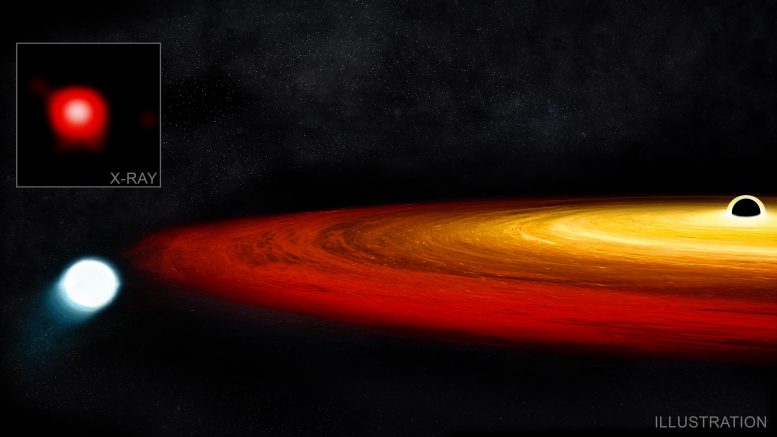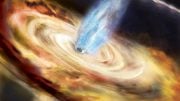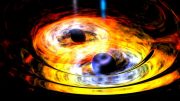
Astronomers may have discovered a new kind of survival story: a star that had a brush with a giant black hole and lived to tell the tale through exclamations of X-rays. Data from NASA’s Chandra X-ray Observatory and ESA’s XMM-Newton uncovered the account that began with a red giant star wandering too close to a supermassive black hole in a galaxy about 250 million light years from Earth. The black hole, located in a galaxy called GSN 069, has a mass about 400,000 times that of the Sun, putting it on the small end of the scale for supermassive black holes.
Credit: X-ray: NASA/CXO/CSIC-INTA/G.Miniutti et al.; Illustration: NASA/CXC/M. Weiss
Astronomers may have discovered a new kind of survival story: a star that had a brush with a giant black hole and lived to tell the tale through exclamations of X-rays.
Data from NASA’s Chandra X-ray Observatory and ESA’s XMM-Newton uncovered the account that began with a red giant star wandering too close to a supermassive black hole in a galaxy about 250 million light years from Earth. The black hole, located in a galaxy called GSN 069, has a mass about 400,000 times that of the Sun, putting it on the small end of the scale for supermassive black holes.
Once the red giant was captured by the black hole’s gravity, the outer layers of the star containing hydrogen were stripped off and careened toward the black hole, leaving the core of the star – known as a white dwarf – behind.
“In my interpretation of the X-ray data the white dwarf survived, but it did not escape,” said Andrew King of the University of Leicester in the UK, who performed this study. “It is now caught in an elliptical orbit around the black hole, making one trip around about once every nine hours.”
As the white dwarf makes its nearly thrice-daily orbit, the black hole pulls material off at its closest approach (no more than 15 times the radius of the event horizon – the point of no return – away from the black hole). The stellar detritus enters into a disk surrounding the black hole and releases a burst of X-rays that Chandra and XMM-Newton can detect. In addition, King predicts gravitational waves will be emitted by the black hole and white dwarf pair, especially at their nearest point.
What would be the future of the star and its orbit? The combined effect of gravitational waves and an increase in the star’s size as it loses mass should cause the orbit to become more circular and grow in size. In this case, the rate of mass loss steadily slows down, and the white dwarf slowly spirals away from the black hole.
“It will try hard to get away, but there is no escape. The black hole will eat it more and more slowly, but never stop,” said King. “In principle, this loss of mass would continue until and even after the white dwarf became a planet, with a mass similar to Jupiter, in about a trillion years. This would be a remarkably slow and convoluted way for the universe to make a planet!”
Astronomers have found many stars that have been completely torn apart by encounters with black holes (so-called tidal disruption events), but there are very few reported cases of near misses, where the star likely survived.
Grazing encounters like this should be more common than direct collisions given the statistics of cosmic traffic patterns, but they could easily be missed for a couple of reasons. First, it can take a more massive, surviving star too long to complete an orbit around a black hole for astronomers to see repeated bursts. Another issue is that supermassive black holes that are much more massive than the one in GSN 069 may directly swallow a star rather than the star falling into orbits where they periodically lose mass. In these cases, astronomers wouldn’t observe anything.
“In astronomical terms, this event is only visible to our current telescopes for a short time – about 2,000 years,” said King. “So unless we were extraordinarily lucky to have caught this one, there may be many more that we are missing. Such encounters could be one of the main ways for black holes the size of the one in GSN 069 to grow.”
King predicts that the white dwarf has a mass of only two tenths the mass of the Sun. If the white dwarf was the core of the red giant that was completely stripped of its hydrogen, then it should be rich in helium. The helium would have been created by the fusion of hydrogen atoms during the evolution of the red giant.
“It’s remarkable to think that the orbit, mass and composition of a tiny star 250 million light years away could be inferred,” said King.
King made a prediction based on his scenario. Because the white dwarf is so close to the black hole, effects from the Theory of General Relativity mean that the direction of the orbit’s axis should wobble, or “precess.” This wobble should repeat every two days and may be detectable with sufficiently long observations.
A paper describing these results appears in the March 2020 issue of the Monthly Notices of the Royal Astronomical Society. NASA’s Marshall Space Flight Center manages the Chandra program. The Smithsonian Astrophysical Observatory’s Chandra X-ray Center controls science and flight operations from Cambridge and Burlington, Massachusetts.
Reference: ” GSN 069 – A tidal disruption near miss” by Andrew King, 7 February 2020, Monthly Notices of the Royal Astronomical Society.
DOI: 10.1093/mnrasl/slaa020
arXiv: 2002.00970









what happens when you add silicon to graphene?
what happens when you place a magnet around a electric magnetic cloud?
The combined effect of gravitational waves and an increase in the star’s size as it loses mass should cause the orbit to become more circular and grow in size. In this case, the rate of mass loss steadily slows down, and the white dwarf slowly spirals away from the black hole.
How does the star’s size increase as it loses mass?
Sorry, the only thing that can be called a fact in this whole article is this: Chandra and XMM-Newton can detect a burst of X-rays.
Everything else in the article is speculation not supported by any scientific experimental data whatsoever.
If anyone believes this trash they are lost and blind.
The star has not survived completely until, the servant is fully payed!
The process has not yet happened, so the star will be trapped again, and if no monies of the servant start flowing into the servant’s bank, the star will eventually be swallowed!! Such a sad ending for an adamant 🌟 that keeps testing the blackhole event horizon!! So the 🌟 be ware, no survival until the fees of the servant are fully paid!
Does anyone know a site that posts legitimate facts regarding an observerd event in a way your ordinary reader can still understand just without the speculative BS?
All these sites have is article after article of science porn to gain more readers
What’s going to happen is the black hole is going to keep stripping off the gases of the star leaving it just a white hot dense ball, eventually causing it to explode into a smaller version of The Big bang is known as the big bounce because as this white ball gets hotter and hotter it deploads and causing another wormhole.See this is where scientists like Einstein were wrong about black holes they are not just bottomless pit that rips everything apart, they’re actually wormholes to pull God’s creation into a new universe! It happens four times to become eternal. That’s why we are not to lose faith in him but only to build it as we make our ancestries souls stronger through power of our prayers our relationship between God is how time is actually created! From the gravitational pull from the bands of the pool of the supermassive black hole in the middle of the center of the Milky Way galaxy pulls its spiral arms around and around in circles and which we know as orbital space time.
Guys, listen, guys, what if we split the hadrons with, guys, what if we split the hadrons with neutrons of sufficient magnitude? What?! Quark physicists got here first? Oh well, guess you won’t want to hear about global wavefunction edge entanglement.
You literally said it escapes right before giving a quote saying it’ll never escape lmao wtf
What if the black hole is the worm hole to another dimension. This dimension is a place where their are beings with knowledge, strength, and super natural powers in existence. What if sphagettification did not kill you, but held you in place at a warp speed until you reached this new unknown dimension. I think this theory should be explored in the distant future.
As idiotic as your writing, here’s one, comets are in hot pursuit at anything that might pursuitable.